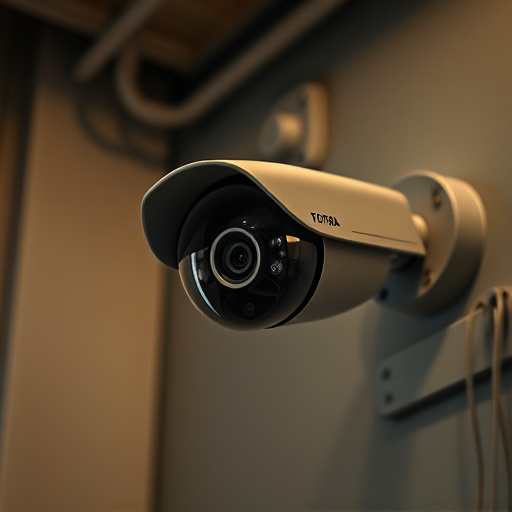Solar-powered dummy camera setups offer a sustainable and low-maintenance security solution. Crafted to mimic active systems, these housings blend seamlessly into environments, acting as effective deterrents. Strategic placement near entry points maximizes their deterrent effect, while regular maintenance ensures optimal performance. These setups provide an aesthetically pleasing and robust security enhancement for homes and businesses.
An empty security camera housing unit, while seemingly simple, offers a unique solution for enhancing surveillance without the cost of active cameras. This article explores the creative integration of solar panels into dummy camera setups, providing a sustainable and aesthetically pleasing alternative. We delve into design options, placement strategies for optimal visibility, and maintenance tips to ensure longevity. Discover how solar-powered dummy cameras can add an effective yet subtle layer of security to any location.
- Solar Panel Integration: Powering the Dummy Camera
- Design and Aesthetics: Crafting an Empty Housing
- Placement Strategies for Optimal Visibility
- Maintenance and Durability: Ensuring Longevity
Solar Panel Integration: Powering the Dummy Camera
Many modern security camera systems, especially those designed for long-term surveillance in remote locations, are now integrating solar panel technology for power generation. This innovative approach to powering dummy cameras offers several advantages, primarily in terms of sustainability and ease of deployment. By harnessing the energy from sunlight, solar-powered dummy camera setups can operate independently without the need for frequent battery replacements or complex electrical wiring.
The integration of solar panels typically involves strategically placing thin-film solar cells on the exterior of the security camera housing to capture sunlight during daylight hours. These panels are designed to be efficient and low-profile, ensuring minimal impact on the overall aesthetics of the setup while still providing ample power to keep the dummy camera operational for extended periods. This eco-friendly approach not only reduces maintenance costs but also contributes to a greener and more sustainable security solution.
Design and Aesthetics: Crafting an Empty Housing
The design and aesthetics of an empty security camera housing unit play a crucial role in its effectiveness as a deterrent and its integration into various environments. When crafting an empty housing, the focus should be on creating a realistic and convincingly dummy setup while maintaining a visually appealing and harmonious appearance. One innovative approach is to incorporate solar-powered components, such as a dummy camera placed within the housing, powered by renewable energy sources. This not only adds a layer of environmental friendliness but also enhances the overall design, making it more aesthetically pleasing.
The housing itself should be meticulously designed to mimic the look and feel of an active security camera system. This involves using materials that match the typical construction of such units, ensuring seamless integration into existing infrastructure. By combining sleek lines, modern aesthetics, and thoughtful detailing, the empty housing can blend seamlessly into various settings, from bustling urban streets to quiet suburban neighborhoods, without drawing unnecessary attention. This subtle yet effective approach ensures that potential intruders are left guessing, making it a powerful tool in enhancing security measures.
Placement Strategies for Optimal Visibility
Placement is key when it comes to maximizing the effectiveness of security camera systems, especially when utilizing solar-powered dummy camera setups. These static cameras are designed to deter potential intruders and provide a sense of security, so strategic placement is essential for optimal visibility. Consider positioning these devices in areas with high foot traffic or visible lines of sight across your property.
For instance, placing the dummy cameras near entry points like doors and windows, or along fences and perimeters, can serve as a powerful deterrent. Additionally, installing them on rooftops or elevated positions offers a broader field of view and ensures that hard-to-reach areas are covered. This strategic approach enhances overall security while also making it more challenging for criminals to go unnoticed.
Maintenance and Durability: Ensuring Longevity
Empty security camera housing units, often referred to as dummy cameras or solar-powered setups, offer a unique solution for enhancing home and business security. Their longevity depends on regular maintenance, mirroring the care required for any outdoor equipment. This includes cleaning the housing to prevent dust buildup, which can affect performance, and ensuring the solar panel is free from obstructions allowing maximum sunlight exposure for efficient charging.
Additionally, protecting the unit from extreme weather conditions is crucial. While many modern dummy cameras are built to withstand various climates, harsh elements like heavy rain, snow, or strong winds can accelerate wear and tear. Regular inspection for any signs of damage or loose connections is essential to ensure optimal durability, thereby maximizing the return on investment in your security system.
A Solar Powered Dummy Camera Setup offers a sophisticated security solution with its sleek design, energy efficiency, and strategic placement. By integrating solar panels, these cameras ensure reliable power without constant maintenance. The aesthetic appeal of the empty housing unit allows for seamless integration into various environments while providing optimal visibility. With proper care, these dummy camera setups can endure outdoor conditions, making them a durable addition to any security regimen.
